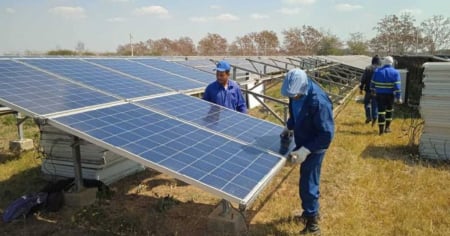The "La Sabana" photovoltaic solar park, located in Bayamo, in the province of Granma, synchronized this weekend with the National Electric System (SEN), according to the official press of the regime.
The third of the 92 inaugurated solar photovoltaic parks, which the Government aims to use to rescue the declining SEN, will contribute 21.8 Megawatts of generation.
"La Sabana" was inaugurated this Friday by Vice Prime Minister Ramiro Valdés Menéndez; Vicente La O Levy, Minister of Energy and Mines; Yudelkis Ortiz Barceló, first secretary of the Party in Granma, and Governor Yanetsy Terry Gutiérrez, during a political and cultural event that the regime used to triumphantly celebrate what it considers a "labor achievement" in the creation of the park.
With a technical advisory team from the People's Republic of China, the construction of the solar park involved 600 workers and 24 companies at different stages of the project's execution.
According to the information that has emerged, a second photovoltaic park similar to the one in Bayamo is currently being implemented in the municipality of Niquero, and others will be constructed in the municipalities of Manzanillo and Río Cauto.
The regime has already launched three photovoltaic parks in Cuba, donated by the Chinese Agency for International Cooperation and Development.
The authorities have emphasized the commitment to adding 1,000 MW to the Cuban energy matrix through upcoming investments in photovoltaic parks. However, these projections are confronted with the harsh reality of an outdated and poorly managed system.
At the inauguration of the first one in Havana, both the leader Miguel Díaz-Canel and Commander Ramiro Valdés participated. Located in the Cotorro municipality, the "Nursing School" park was the first of these facilities from the so-called Project B.
In the midst of the worst energy crisis in its history, the Cuban regime promised to generate nearly 600 MW of solar photovoltaic energy during the first half of 2025.
On March 1st, the government inaugurated the second solar photovoltaic park "Alcade Mayor" in Cienfuegos, with a capacity of 21 MW, as part of its strategy to promote renewable energies and reduce dependence on fossil fuels.
For this month, it was also promised to synchronize the Parque Solar Fotovoltaico Ciego Norte, in the province of Ciego de Ávila, with a generation capacity of 21.87 megawatts (MW), which is in its final assembly phase.
To alleviate the energy crisis and in its effort to promote renewable energies, the Cuban government has relied on the support of China.
In November of last year, during the International Fair of Havana, Hangzhou Duojia Technology Co. Ltd reaffirmed its commitment to the energy transition of the island, stating that solar panels are the "definitive solution" to Cuba's electricity crisis.
However, the crisis of the SEN continues to severely impact the population, with extended blackouts reflecting the structural deterioration of the electricity industry, a direct result of years of poor governmental management.
The forecasts for the peak hours indicate a availability of only 1970 MW compared to an estimated demand of 3050 MW, which would result in a deficit of 1080 MW and calculated impacts of 1150 MW.
Multiple thermoelectric units remain out of service. Unit 2 of the Felton Thermoelectric Power Plant and Unit 3 of the Santa Cruz Thermoelectric Power Plant are currently down for repairs, while five other units are halted for maintenance at key plants such as Mariel, Cienfuegos, Santa Cruz, and Renté.
Frequently Asked Questions about the Energy Crisis and Solar Parks in Cuba
What is the "La Sabana" photovoltaic solar park and what is its capacity?
The photovoltaic solar park "La Sabana" is located in Bayamo, Granma Province, and was recently synchronized with the National Electric System (SEN) of Cuba. This park has a generation capacity of 21.8 megawatts and is the third of the 92 solar parks planned in the Cuban government's project to enhance the energy matrix of the island.
What is China's role in the development of solar parks in Cuba?
China has been a key partner in the development of solar parks in Cuba, providing technology and equipment for these projects. The China International Development Cooperation Agency has donated three photovoltaic parks that are already operational on the island. Additionally, Chinese companies such as Hangzhou Duojia Technology Co. Ltd have reaffirmed their commitment to Cuba's energy transition by sending containers of solar panels and lithium batteries for additional projects.
What challenges does the Cuban electricity system face despite the installation of solar parks?
The Cuban electrical system faces serious challenges despite the installation of solar parks. The National Electric System (SEN) remains outdated and poorly managed, resulting in prolonged blackouts and insufficient generation capacity to meet demand. Furthermore, multiple thermoelectric units are out of service due to breakdowns and lack of maintenance, exacerbating the energy crisis in the country.
What projections has the Cuban government made regarding solar energy generation?
The Cuban government has projected to add 1,000 megawatts (MW) to the national energy matrix through investments in photovoltaic parks. These projects are expected to contribute nearly 600 MW of photovoltaic solar energy during the first half of 2025. However, these promises are facing a complicated reality due to a lack of resources and a decaying electrical system.
Filed under:
